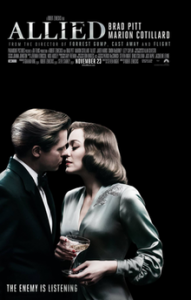film review: allied

Allied opens in Casablanca, 1942, where Canadian intelligence officer Max Vatan (Brad Pitt) and French Resistance fighter Marianne Beauséjour (Marion Cotillard) meet to work undercover. The pair pretend to be husband and wife, and befriend a group of Nazis in order to gain access to an event attended by the German ambassador. While working together, Max and Marianne fall in love, marry, and move to London, where Marianne gives birth to their daughter, Anna, and Max returns to work. However, Max’s superiors raise doubts about Marianne’s identity, revealing that she may in fact be a German spy. Max must find out if the woman he loves has betrayed him and the cause he has dedicated his life to. Is the life they have created together a lie? Directed by Robert Zemeckis (Back to the Future, Forrest Gump) and written by Steven Knight (Eastern Promises, Locke), the film blends the suspense/thriller genre with romance, producing an often-compelling portrait of intimate betrayal in wartime.
Throughout, Allied pays homage to classical Hollywood cinema. This is most obvious in the film’s references to Casablanca (Michael Curtiz 1942) – it opens in the city of Casablanca, in the year that the classic film premiered. The song La Marseillaise, which features in a poignant scene in Curtiz’s classic, also features in Allied. Cotillard and Pitt certainly don’t generate the same smouldering chemistry that Bogart and Bergman do, but they carry the film well. The film’s focus on duplicity, doubles, paranoia and anxiety, corruption, and the mystery of the woman that must be investigated and solved, draws on the tradition of the Hitchcockian suspense thriller. Sumptuous silk gowns and impeccably tailored suits, coupled with lush, warmly lit sets, also go a long way to evoke the glamour of the period. Cotillard in particular plays with classical Hollywood’s feminine archetypes of the duplicitous, calculating femme fatale and the noble romance heroine, delivering a more complex and interesting performance than Pitt.
The gendered dynamics of the film’s action and sex scenes are refreshing, providing a clever update on the classical Hollywood formula. In action sequences, Marianne demonstrates an expert, ruthless precision with weaponry to match Max’s. They are equally intelligent, resourceful, brave, pragmatic, and capable. This equality is maintained throughout most (though not all) of the film, and it is fantastic to see. In sex scenes, there are no fetishizing close-ups on her body focalised through his gaze. Instead, these scenes carefully focus on mutual pleasure in shots of the lovers’ bodies entwined together. In many sex scenes in cinema, the female body is often isolated within the frame, her scantily clad body investigated in a close-up while the male character looks at her; this produces a dynamic in which women are objectified in relation to male desire. Overall, Zemeckis carefully avoids these problems, and instead participates in the slowly shifting terrain of gender relations in contemporary Hollywood storytelling.
While these elements are fresh and fun to watch, the film’s ending is saccharine and cliché, following the overly familiar plot of female sacrifice for husband and child. The end is generic and uninspired, neatly ironing out the more complex twists and turns set up earlier in the film. I was left wanting more intrigue, thrills and labyrinthine plot twists from this film, which falls flat in the final act. This ultimate deflation of the film’s earlier vitality is disappointing in an otherwise enjoyable and well-crafted movie.
Allied is an entertaining film that features some fun references to cinematic history, a lavishly rich and glossy mise-en-scène, as well as a good dose of romance and intrigue. It doesn’t deliver the romance in the same devastating, heartbreaking manner as Casablanca, nor does it produce suspense in the masterful, thrilling way that Hitchcock does, despite its best efforts. Nevertheless, its balance of nostalgia and homage with a contemporary twist on the gender dynamics of the central pair sustains interest, and opens up a space for a strong female character to shine.
Dr Athena Bellas teaches at the University of Melbourne, tweets at @AthenaBellas and blogs and podcasts at teenscreenfeminism.wordpress.

